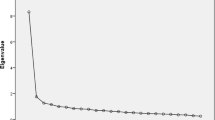Abstract
A revised Stroop color-naming task was used to test hypotheses derived from Beck's cognitive theory of anxiety disorders which proposes that social phobics are hypervigilant to social-evaluative threat cues. Color-naming latencies for social and physical threat words were compared to matched neutral words for both social phobics and individuals with panic disorder. As predicted, social phobics showed longer latencies for social threat words, and panickers had longer latencies for physical threat words. Latency for color-naming social threat words correlated with self-reported avoidance among social phobics. These results are consistent with Beck's notion of self-schemata which facilitate the processing of threat cues. Methodological issues and clinical implications are discussed.
Similar content being viewed by others
References
American Psychiatric Association. (1987).Diagnostic and statistical manual of mental disorders (3rd ed., rev.). Washington, DC: Author.
Beck, A. T., & Emery, G. (1985).Anxiety disorders and phobias: A cognitive perspective. New York: Basic Books.
Byrne, D. (1971).The attraction paradigm. New York: Academic Press.
Cacioppo. J. T., Glass, C. R., & Merluzzi, T. V. (1979). Self-statements and self-evaluations: A cognitive-response analysis of heterosocial anxiety.Cognitive Therapy and Research, 3 249–262.
Caroll, J. B., Davies, P., & Richman, B. (1971).Word frequency book. Boston: Houghton Mifflin.
Clark, J. V., & Arkowitz, H. (1975). Social anxiety and self-evaluation of interpersonal performance.Psychological Reports, 36 211–221.
Dodge, C. S., Hope, D. A., Heimberg, R. G., & Becker, R. E. (1988). Evaluation of the Social Interaction Self-Statement Test with a social phobic population.Cognitive Therapy and Research, 12 211–222.
DiNardo, P. A., & Barlow, D. G. (1988).The anxiety disorders interview schedule, revised (ADISR). Center for Stress and Anxiety Disorders, University at Albany, State University of New York, Albany, New York.
DiNardo, P. A., O'Brien, G. T., Barlow, D. H., Waddell, M. T., & Blanchard, E. B. (1983). Reliability of DSM-III anxiety disorder categories using a new structured interview.Archives of General Psychiatry, 40 1070–1074.
Dyer, F. N. (1973). The Stroop phenomenon and its use in the study of perceptual, cognitive, and response processes.Memory and Cognition, 1 106–120.
Foa, E. G., & McNally, R. J. (1986). Sensitivity to feared stimuli in obsessive-compulsives: A dichotic listening analysis.Cognitive Therapy and Research, 10 477–485.
Glass C. R., Merluzzi, T. V., Biever, J. L., & Larsen, K. H. (1982). Cognitive assessment of social anxiety: Development and validation of a self-statement questionnaire.Cognitive Therapy and Research, 6 37–55.
Goldfried, M. R., Padawer, W., & Robins, C. (1984). Social anxiety and the semantic structure of heterosocial interactions.Journal of Abnormal Psychology, 93 87–97.
Hartman, L. M. (1984). Cognitive components of social anxiety.Journal of Clinical Psychology, 40 137–139.
Heimberg, R. G., Acerra, M. C., & Holstein, A. (1985). Partner similarity mediates interpersonal anxiety.Cognitive Therapy and Research, 9 443–453.
Heimberg, R. G., Becker, R. E., Goldfinger, K. & Vermilyea, J. A. (1985). Treatment of social phobia by exposure, cognitive restructuring and homework assignments.Journal of Nervous and Mental Disease, 173 236–245.
Heimberg, R. G., Dodge, C. S., Hope, D. A., Kennedy, C. R., Zollo, L., & Becker, R. E. (1990). Cognitive-behavioral group treatment for social phobia: Comparison to a credible placebo control.Cognitive Therapy and Research, 14 1–23.
Heimberg, R. G., Hope, D. A., Dodge, C. S., & Becker, R. E. (1990). DSM-III-R subtypes of social phobia: Comparison of generalized social phobics and public speacking phobics.Journal of Nervous and Mental Disease, 178 172–179.
Hope, D. A., & Heimberg, R. G. (1988). Public and private self-consciousness and social phobia.Journal of Personality Assessment, 52 626–639.
Hope, D. A., Heimberg, R. G., & Klein, J. F. (1990). Social anxiety and the recall of interpersonal information.Journal of Cognitive Psychotherapy: An International Quarterly (in press).
MacLeod, C., Mathews, A., & Tata, P. (1986). Attentional bias in emotional disorders.Journal of Abnormal Psychology, 95 15–20.
Mathews, A., & MacLeod, C. (1985). Selective processing of threat cues in anxiety states.Behaviour Research and Therapy, 23 563–569.
Mathews, A., & MacLeod, C. (1986). Discrimination of threat cues without awareness in anxiety states.Journal of Abnormal Psychology, 95 131–138.
O'Banion, K., & Arkowitz, H. (1977). Social anxiety and selective attention for affective information about the self.Social Behavior and Personality, 5 321–328.
Robins, C. J. (1987). Social perception and heterosocial self-efficacy: A multidimensional scaling analysis.Cognitive Therapy and Research, 11 197–214.
Shipley, W. P. (1939).Shipley-Institute of Living Scale for Measuring Intellectual Impairment: Manual for directions and scoring. Hartford, Connecticut: Institute of Living.
Smith, T. W., Ingram, R. E., & Brehm, S. S. (1983). Social anxiety, anxious self-preoccupation, and recall of self-relevant information.Journal of Personality and Social Psychology, 44 1276–1283.
Smith, R. E., & Sarason, I. G. (1975). Social anxiety and the evaluation of negative interpersonal feedback.Journal of Consulting and Clinical Psychology, 43 429.
Stroop, J. R. (1938). Factors affecting speed in serial verbal reactions.Psychological Monographs, 50 38–48.
Watson, J. P., & Marks, I. M. (1971). Relevant and irrelevant fear in flooding: A crossover study of phobic patients.Behavior Therapy, 2 275–295.
Watts, F. N., McKenna, F. P., Sharrock, R., & Trezise, L. (1986). Colour naming of phobiarelated words.British Journal of Psychology, 77 97–108.
Author information
Authors and Affiliations
Rights and permissions
About this article
Cite this article
Hope, D.A., Rapee, R.M., Heimberg, R.G. et al. Representations of the self in social phobia: Vulnerability to social threat. Cogn Ther Res 14, 177–189 (1990). https://doi.org/10.1007/BF01176208
Issue Date:
DOI: https://doi.org/10.1007/BF01176208




